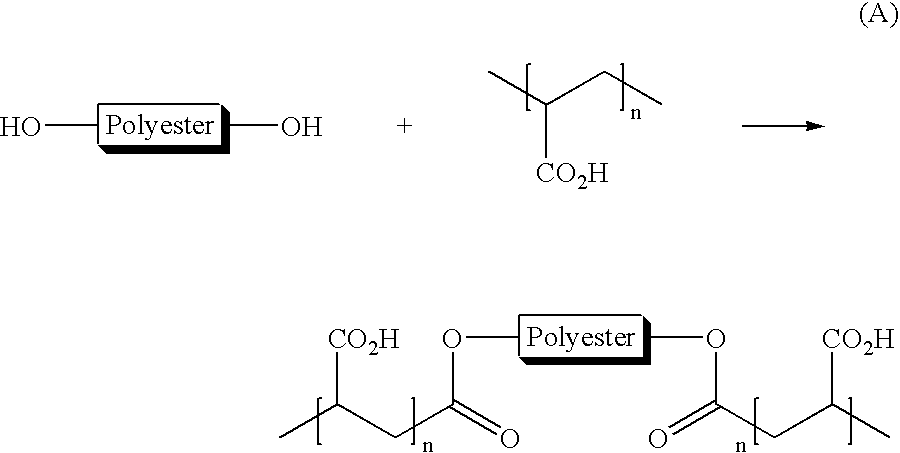Toner compositions
a technology of compositions and toners, applied in the field of toner compositions and processes, can solve the problems of difficult reduction to small particles, affecting the quality of toners, so as to improve the cohesion and reduce the properties of melt fusion
- Summary
- Abstract
- Description
- Claims
- Application Information
AI Technical Summary
Benefits of technology
Problems solved by technology
Method used
Image
Examples
example 1
Synthesis of an Amorphous Acidic Polyester Resin Having Pendant Carboxylic Acid Groups at an End of the Polyester Resin Chain Using Trimellitic Anhydride
[0107]A one liter Parr reactor equipped with a heating mantle, mechanical stirrer, bottom drain valve and distillation apparatus was charged with propylene glycol (262 grams), diethylene glycol (28.5 grams), dipropylene glycol (118.5 grams), n-butylstannoic acid (FASCAT 4100) catalyst (0.75 grams), trimethanol propane (6.0 grams) and dimethyl terephthate (436 grams). The reaction was slowly heated to 150° C. over 1 hour under a stream of CO2, with stirring started at 140° C. The temperature is then increased from 150° C. by 15° C. and subsequently 10° C. intervals, every 30 minutes to 180° C. During this time, water and methanol were distilled as a by-product. The temperature was then increased by 5° C. intervals over a 1 hour period to 195° C. The pressure was then reduced to 0.03 mbar over a 2 hour period and any excess glycols we...
example 2
Synthesis of a Crystalline Polyester Resin Having Pendant Carboxylic Acid Groups at an End of the Polyester Resin Chain Using Trimellitic Anhydride
[0108]A one liter Parr reactor equipped with a heating mantle, mechanical stirrer, bottom drain valve and distillation apparatus was charged with dodecanedioic acid (443.6 grams), fumaric acid (18.6 grams), hydroquinone (0.2 grams), n-butylstannoic acid (FASCAT 4100) catalyst (0.7 grams), ethylene glycol (248 grams). The materials were stirred and slowly heated to 150° C. over 1 hour under a stream of CO2. The temperature was then increased by 15° C. and subsequently 10° C. intervals, every 30 minutes to 180° C. During this time, water was distilled as a by product. The temperature was then increased by 5° C. intervals over a 1 hour period to 195° C. The pressure was then reduced to 0.03 mbar over a 2 hour period and any excess glycols were collected in the distillation receiver. The resin was returned to atmospheric pressure under a stre...
example 3
Synthesis of an Amorphous Acidic Polyester Resin Using a Hydroxyl-Terminated Polyester Resin and Polyacrylic Acid
[0109]A one liter Parr reactor equipped with a heating mantle, mechanical stirrer, bottom drain valve and distillation apparatus was charged with propylene glycol (262 grams), diethylene glycol (28.5 grains), dipropylene glycol (118.5 grams), FASCAT 4100 catalyst (0.75 grams), trimethanol propane (6.0 grains) and dimethyl terephthate (436 grams). The reaction was slowly heated to 150° C. over 1 hour under a stream of CO2, with stirring started at 140° C. The temperature was then increased from 150° C. by 15° C. and subsequently 10° C. intervals, every 30 minutes to 180° C. During this time, water and methanol were distilled as a by product. The temperature was then increased by 5° C. intervals over a 1 hour period to 195° C. The pressure was then reduced to 0.03 mbar over a 2 hour period and any excess glycols were collected in the distillation receiver. The resin was ret...
PUM
| Property | Measurement | Unit |
|---|---|---|
| mol % | aaaaa | aaaaa |
| melting point | aaaaa | aaaaa |
| melting point | aaaaa | aaaaa |
Abstract
Description
Claims
Application Information
 Login to View More
Login to View More - R&D
- Intellectual Property
- Life Sciences
- Materials
- Tech Scout
- Unparalleled Data Quality
- Higher Quality Content
- 60% Fewer Hallucinations
Browse by: Latest US Patents, China's latest patents, Technical Efficacy Thesaurus, Application Domain, Technology Topic, Popular Technical Reports.
© 2025 PatSnap. All rights reserved.Legal|Privacy policy|Modern Slavery Act Transparency Statement|Sitemap|About US| Contact US: help@patsnap.com



